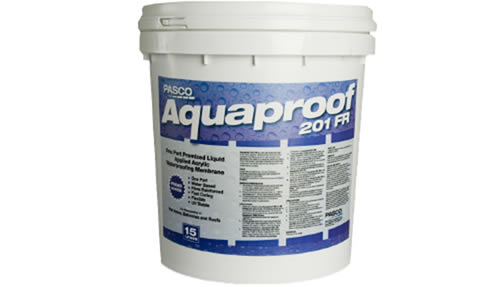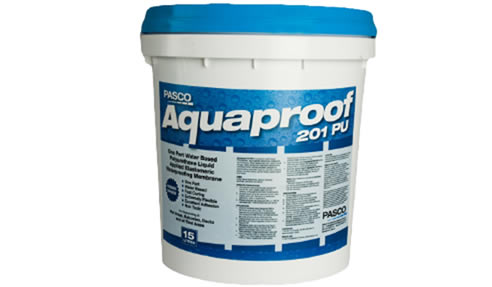Waterproofing uses a combination of different materials to prevent water from seeping into the structural elements of a building. The process of waterproofing entails complex and thorough specifications from the architect and building designer since it is a method which integrates some building components, such as roofs, walls, basements, and foundations.
Pasco Construction Solutions is a Victoria-based company that supplies an extensive range of waterproofing and silicone sealant products in the market today. Pasco wants to share their expertise and raise awareness on the vast number of waterproofing methods and products, focusing on the ultimate goal of helping each client choose the appropriate waterproofing or construction materials that suit their specifications.
Pasco is the proud distributor and supplier of Aquaproof 201PU and Aquaproof 201FR waterproofing membranes.
Aquaproof 201PU is compatible to use in bathroom applications like shower recesses and under tiles. It can also be used on balconies and laundry areas. The easy-to-apply liquid waterproofing membrane conforms to the AS/NZS 4858:2004.

Aquaproof 201FR Waterproofing Membrane from Pasco
Aquaproof 201FR is a one part, liquid membrane, which has microfibres for additional strength. It removes the need for an additional reinforcing fabric. Aquaproof 201FR is suitable for all wet area and balcony applications.
Aquaproof 201FR waterproofing membrane can be easily applied to under tiles, shower recesses, laundry areas and balconies.
Several components contribute to waterproofing, such as drainage composites that directs water away from the structure.
Location of Waterproofing Membrane
a. Positive Side
The exterior surface of a structure uses positive waterproofing. To protect the vital structural components from corrosive substances and moisture infiltration, positive waterproofing is necessary.
b. Negative Side
Negative side waterproofing applies to the interior surface of a building structure. This is used to prevent the water from entering into space but doesn't impede the water from seeping into the substrate wall.
Above versus Below Grade Waterproofing
a. Above-grade waterproofing
Above-grade refers to any structure located above the ground level. Waterproofing membranes must be UV-resistant since it's exposed to sunlight. It must also conform to thermal and structural movements. Since above-grade waterproofing is mostly used on balconies, roofs, parking areas, and walls; it must be visually appealing and sturdy enough to handle traffic wear and weathering exposure.
b. Below-grade waterproofing
All building structure requires below-grade waterproofing. Waterproofing membranes must resist hydrostatic pressure, chemical erosion, and must function well in high groundwater level, resilient to structural movement, with low absorption rate and flexible.
Waterproofing has been the bread and butter of Pasco since the company started 11 years ago. Supplying waterproofing materials and other relevant products in the built environment is
just one part of the vision Pasco is instilling among their employees.
For more details on waterproofing membrane products and applications, contact Pasco today.






 Adjustable Pedestal System for Overseas
Adjustable Pedestal System for Overseas Low Viscosity Hydrophilic Epoxy Resin
Low Viscosity Hydrophilic Epoxy Resin High-Performance Fillet Sealant for Fast
High-Performance Fillet Sealant for Fast Carpark Below Ground Waterproofing
Carpark Below Ground Waterproofing Adjustable Pedestals for Paving at
Adjustable Pedestals for Paving at Raised Floor System for Hotel Poolside
Raised Floor System for Hotel Poolside Pedestal Paving and Stair Nosing in
Pedestal Paving and Stair Nosing in Levelling Outdoor Living Area with
Levelling Outdoor Living Area with Hydrophilic Epoxy Resin for Concrete
Hydrophilic Epoxy Resin for Concrete Buzon Adjustable Pedestals for Entrance
Buzon Adjustable Pedestals for Entrance Industrial Grade Thinner for Cleaning
Industrial Grade Thinner for Cleaning Fast Curing Waterproofing Membrane by
Fast Curing Waterproofing Membrane by Neutral Cure Stone Safe Silicone Sealant
Neutral Cure Stone Safe Silicone Sealant Height Adjustable Buzon ScrewJack
Height Adjustable Buzon ScrewJack Waterproofing for Below Ground Car Park
Waterproofing for Below Ground Car Park Wipes for Paints and Stains by Pasco
Wipes for Paints and Stains by Pasco Pedestal System for Passenger Terminal
Pedestal System for Passenger Terminal Caulking Knife Set by Pasco
Caulking Knife Set by Pasco Moisture Curing Polyurethane
Moisture Curing Polyurethane
